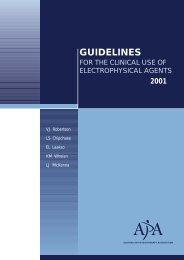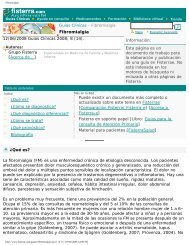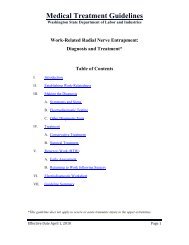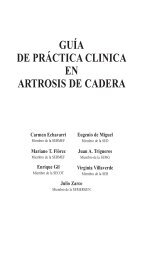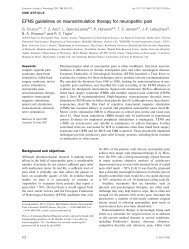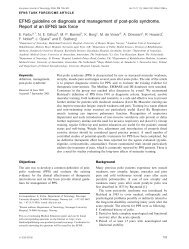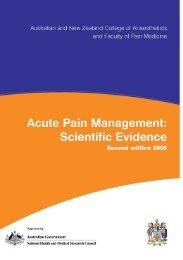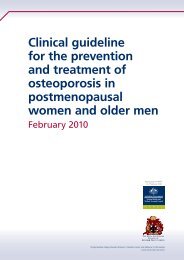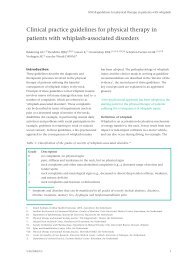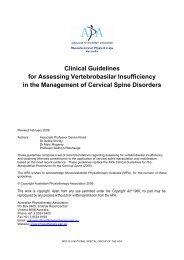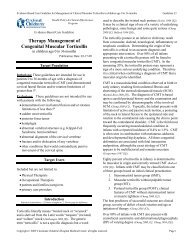Practice Parameter and Literature Review of the Usefulness of ...
Practice Parameter and Literature Review of the Usefulness of ...
Practice Parameter and Literature Review of the Usefulness of ...
Create successful ePaper yourself
Turn your PDF publications into a flip-book with our unique Google optimized e-Paper software.
<strong>Practice</strong> <strong>Parameter</strong>: Carpal Tunnel Syndrome208. Resende LA, Alves RP, Castro HA, Kimaid PA, Fortinguerra CR,Schelp AO. Silent period in carpal tunnel syndrome. Electromyogr<strong>and</strong> Clin Neurophys 2000;40:31-36. Criteria Met (4/6: 1,3,5,6)Source: Medline Search. Abstract: There was no correlation between<strong>the</strong> silent period alterations <strong>and</strong> <strong>the</strong> severity <strong>of</strong> <strong>the</strong> CTS in 20 h<strong>and</strong>s <strong>of</strong>20 CTS patients compared to 20 normal subjects.209. *Rivner MH. Carpal tunnel syndrome: a critique <strong>of</strong> “newer” nerveconduction techniques. In: AAEM 1991 Course D: Focal peripheralneuropathies: selected topics. Rochester, MN: American Association<strong>of</strong> Electrodiagnostic Medicine; 1991. Criteria Met (2/6: 2,6) Source:AAEM Consultant 1993.210. Robinson LR, Micklesen PJ, Wang L. Optimizing <strong>the</strong> number <strong>of</strong> testsfor carpal tunnel syndrome. Muscle Nerve 2000;23:1880-1882.Criteria Met (3/6: 3,5,6). Source: Medline Search. Abstract: Thecombined sensory index (CSI), <strong>the</strong> sum <strong>of</strong> three latency differences,median-ulnar across <strong>the</strong> palm (palmdiff), median-ulnar to <strong>the</strong> ringfinger (ringdiff), <strong>and</strong> median-radial to <strong>the</strong> thumb (thumbdiff), hashigher sensitivity <strong>and</strong> reliability for CTS than individual tests. Theobjective <strong>of</strong> this study was to develop an approach that minimizestesting but maximizes accuracy. A retrospective study <strong>of</strong> 300 h<strong>and</strong>sdetermined that <strong>the</strong>re were endpoints for individual tests thatconfidently predicted <strong>the</strong> results <strong>of</strong> <strong>the</strong> CSI; for ranges between <strong>the</strong>seendpoints, fur<strong>the</strong>r testing was required. These ranges were: palmdiff0-0.3 ms; ringdiff 0.1-0.4 ms; <strong>and</strong> thumbdiff 0.2-0.7 ms. Therefore, if<strong>the</strong> results <strong>of</strong> one <strong>of</strong> <strong>the</strong>se three tests exceeded <strong>the</strong>se values, it was notnecessary to perform all <strong>the</strong> NCS necessary to calculate a CSI withoutloss <strong>of</strong> sensitivity <strong>and</strong> reliability.211. Robinson LR, Micklesen PJ, Wang L. Strategies for analyzing nerveconduction data: superiority <strong>of</strong> a summary index over single tests.Muscle Nerve 1998;21:1166-1171. Criteria Met (5/6: 1,2,3,5,6)Source: Medline Search. Abstract: Comparison <strong>of</strong> three strategies fordiagnosing CTS with NCSs: use <strong>of</strong> a single NCS result; requirementthat one, two, or three <strong>of</strong> three NCSs results to be abnormal; <strong>and</strong> use<strong>of</strong> a single summary variable incorporating data from three differentNCSs. Sixty-five h<strong>and</strong>s <strong>of</strong> subjects without clinical CTS werecompared with 66 h<strong>and</strong>s with clinical CTS. Three latency differenceswere measured: median-ulnar (8 cm) midpalmar orthodromic(palmdiff); median-ulnar ring finger (14 cm) antidromic (ringdiff);<strong>and</strong> median-radial thumb (10 cm) antidromic (thumbdiff). Thecombined sensory index (CSI) was <strong>the</strong> sum <strong>of</strong> <strong>the</strong>se three differences.Sensitivity for <strong>the</strong> tests was palmdiff 69.7%, ringdiff 74.2%,thumbdiff 75.8%, <strong>and</strong> CSI 83.1%. Specificity was 95.4-96.9%.Requiring one, two, or three <strong>of</strong> three tests to be abnormal yieldedsensitivities <strong>of</strong> 84.8%, 74.2%, or 56.1%, respectively, but specificities<strong>of</strong> 92.3%, 98.5%, <strong>and</strong> 100%, respectively. We conclude that acombined index improves diagnostic classification over use <strong>of</strong> singletest results.212. Rojviroj S, Sirichativapee W, Kowsuwon W, Wongwiwattananon J,Tammanthong N, Jeeravipoolvarn P. Pressures in <strong>the</strong> carpal tunnel. Acomparison between patients with carpal tunnel syndrome <strong>and</strong> normalsubjects. J Bone Joint Surg Br 1990;72:516-518. Criteria Met (3/6:1,3,6) Source: Medline Search.213. Rosecrance JC, Cook TM, Bingham RC. Sensory nerve recoveryfollowing median nerve provocation in carpal tunnel syndrome.Electromyogr Clin Neurophysiol 1997;37:219-229. Criteria Met (6/6:1,2,3,4,5,6) Source: Medline Search. Abstract: The latency <strong>and</strong>amplitude <strong>of</strong> orthodromic median SNAP from palm to wrist weremeasured 5 minutes before <strong>and</strong> at intervals up to 10 minutes untilrecovery after sustained maximal wrist flexion combined with <strong>the</strong>fingers simultaneously performing finger flexion against resistance.35 h<strong>and</strong>s with a clinical diagnosis <strong>of</strong> CTS were subdivided into 24with a prolonged baseline latency (+NCS) <strong>and</strong> 11 with normallatencies (-NCS), <strong>and</strong> 25 asymptomatic control h<strong>and</strong>s were studied.Four measures were analyzed: difference in latency <strong>and</strong> amplitudebefore flexion <strong>and</strong> at 2 minutes afterward, time for <strong>the</strong> SNAPamplitude to recover to 95% initial value, <strong>and</strong> time for latency toreturn to initial latency. The latency increased only 1-2% in CTSh<strong>and</strong>s compared to controls, but <strong>the</strong> amplitude decreased to a greaterextent (17%) compared to control h<strong>and</strong>s (2%) <strong>and</strong> <strong>the</strong> amplituderecovery time was longer. For groups, mean recovery times were 0.6min controls, 2.25 min CTS (-NCS) group, <strong>and</strong>, paradoxically, 4.74min for CTS (-NCS) group. Amplitude recovery time greater than1.62 min (asymptomatic mean + 2SD) was considered abnormal forindividual h<strong>and</strong>s. With this criterion, abnormalities were present in71% <strong>of</strong> clinically symptomatic h<strong>and</strong>s, including 8 <strong>of</strong> 11 without o<strong>the</strong>rNCS abnormalities. SNAP recovery time may be complimentary too<strong>the</strong>r NCS to diagnosis CTS but does not replace median orthodromicpalm-wrist SNAP latency measurements to diagnose CTS.214. Rosen I. Neurophysiological diagnosis <strong>of</strong> <strong>the</strong> carpal tunnel syndrome:evaluation <strong>of</strong> neurographic techniques. Sc<strong>and</strong> J Plast Reconstr SurgH<strong>and</strong> Surg 1993;27:95-101. Criteria Met (4/6: 3,4,5,6) Source:Medline Search. Abstract: Retrospective study <strong>of</strong> 28 patientsdiagnosed with CTS on basis <strong>of</strong> combination <strong>of</strong> clinical, NCS <strong>and</strong>EMG data. The median motor DML, orthodromic median SNCV forD1 <strong>and</strong> D3, palmar mixed median NCV were measured <strong>and</strong> <strong>the</strong>quotient <strong>of</strong> SNCV across CT to forearm were calculated in 86 normalcontrols <strong>and</strong> <strong>the</strong> results compared to <strong>the</strong> same studies in <strong>the</strong> 28 CTSpatients. The palmar mixed median NCV was superior to <strong>the</strong> quotient<strong>of</strong> SNCV across CT to forearm <strong>and</strong> <strong>the</strong> o<strong>the</strong>r tests for <strong>the</strong> diagnosis <strong>of</strong>CTS.215. Rosenberg JN. Anterior interosseous/median nerve latency ratio. ArchPhys Med Rehabil 1990;71:228-230. Criteria Met (4/6: 1,3,5,6)Source: Medline Search. Abstract: With stimulation at <strong>the</strong> antecubitalfossa <strong>and</strong> simultaneous recording over <strong>the</strong> APB <strong>and</strong> pronatorquadratus (needle electrode) DMLs were determined from 100anterior interosseous nerves in 61 normal volunteers, 5 patients withanterior interosseous syndrome, <strong>and</strong> 35 patients with CTS. The resultsshow abnormal ratios for both CTS <strong>and</strong> anterior interosseoussyndrome.216. Rossi S, Giannini F, Passero S, Paradiso C, Battistini N, Cioni R.Sensory neural conduction <strong>of</strong> median nerve from digits <strong>and</strong> palmstimulation in carpal tunnel syndrome. Electroencephalogr ClinNeurophysiol 1994;93:330-334.Criteria Met (4/6: 3,4,5,6) Source:Medline Search. Abstract: A variation <strong>of</strong> palmar stimulation withmore distal stimulation over <strong>the</strong> metacarpophalangeal interspaces sothat <strong>the</strong> conduction distances was 1-1.5 cm longer than <strong>the</strong> usual 8 cmorthodromic palmar conduction study. The more distal stimulationwas performed to evaluate <strong>the</strong> median nerve palmar branches to <strong>the</strong>adjacent surfaces <strong>of</strong> <strong>the</strong> index <strong>and</strong> middle finger (P2), <strong>the</strong> middlefinger <strong>and</strong> ring finger (P3), <strong>and</strong> <strong>the</strong> ulnar palmar branches to <strong>the</strong>adjacent surfaces <strong>of</strong> <strong>the</strong> ring <strong>and</strong> little finger (P4). The authors notedthat <strong>the</strong> sensitivity <strong>of</strong> <strong>the</strong> modified orthodromic palmar studyparalleled <strong>the</strong> sensitivity <strong>of</strong> orthodromic median sensory digitstimulation studies to diagnose CTS. The modified palmar stimulationtechnique had <strong>the</strong> advantages (1) <strong>of</strong> frequently demonstrating ameasurable response in CTS patients with stimulation at P3 whereas<strong>the</strong> response was absent with stimulation <strong>of</strong> D4 <strong>and</strong> (2) <strong>of</strong>demonstrating an abnormality when <strong>the</strong> response with stimulation atP2 was normal. Since <strong>the</strong> authors used NCS criteria to select patientsfor <strong>the</strong> study, <strong>the</strong> clinical sensitivity <strong>and</strong> specificity <strong>of</strong> <strong>the</strong> modifiedpalmar studies could not be calculated although <strong>the</strong>y could compare<strong>the</strong> sensitivity <strong>of</strong> one study to ano<strong>the</strong>r.217. Sackett DL, Straus SE, Richardson WS, Rosenberg W, Haynes RB.Evidence-based medicine: how to practice <strong>and</strong> teach EBM. NewYork: Churchill Livingstone: 2000. Background Reference. Source:AAEM 2000 CTS Task Force member.218. Salerno DF, Franzblau A, Werner RA, Bromberg MB, Armstrong TJ,Albers JW. Median <strong>and</strong> ulnar nerve conduction studies amongworkers: normative values. Muscle Nerve 1998;21:999-1005. CriteriaMet: (normal population study 4/6: 1,2,5,6) Source: Medline Search:Abstract: To determine normative values for NCS among activeworkers, a prospective cross-sectional study was performed <strong>of</strong> activeworkers in contrast to <strong>the</strong> typical reference populations. The authorsselected a subset <strong>of</strong> 326 workers from 955 subjects who participatedin medical surveys in <strong>the</strong> workplace. Bilateral median (D2) <strong>and</strong> ulnar(D5) antidromic sensory conduction studies over a 14 cm conductiondistance to <strong>the</strong> wrist were performed after checking midpalmtemperature to be 32.0 degrees centigrade or greater with or withoutwarming <strong>the</strong> limb; limb temperatures were not monitoring during <strong>the</strong>study (personal communication). Median <strong>and</strong> ulnar SNAP amplitude<strong>and</strong> latency (onset <strong>and</strong> peak) were measured. Workers with upperextremity symptoms, medical conditions that could adversely affectperipheral nerve function, low h<strong>and</strong> temperature, or highly repetitivejobs were excluded from <strong>the</strong> “normal” cohort. Linear regressionmodels explained variance in nerve function with covariate <strong>of</strong> age,sex, h<strong>and</strong> temperature, <strong>and</strong> anthropometric factors <strong>and</strong> provideS972 CTS <strong>Literature</strong> <strong>Review</strong>© 2002 American Association <strong>of</strong> Electrodiagnostic Medicine



